Topic area:
Physical Geography
Sub-topic area:
Soils in Rwanda
Key unit competence
By the end of this unit, you should be able
to compare different soil types and assess
their importance to Rwanda.
Unit objectives
By the end of this unit, you should be able to:
• State the different types of soils in
Rwanda.
• Identify the causes and effects of soil
erosion in Rwanda.
• Identify the importance of soil to
Rwanda.
Soil
Activity 5.1
Work in pairs.
Study the following photograph and answer
the questions that follow.
1. Name what sample X represents.
2. Discuss the composition of sample X.
3. Explain why sample X appears in
different colours.
4. List the uses of sample X.
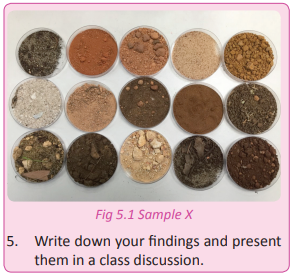
In Senior One, you learnt about soils.
You studied the soil formation processes,
properties of soil, soil profile, soil catena,
different types of soils and the importance
of soils. In Senior Four, you are going to
study the different types of soils in Rwanda,
causes and effects of soil erosion and the
importance of soil to Rwanda.
Definition of soil
Soil is the upper layer of the Earth in which
plants grow. It is made up of a mixture of
rock particles, organic matter, minerals,
gases, liquids, air and living organisms that
support life.
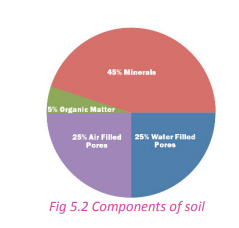 Types of soils and where they are
found in Rwanda
Types of soils and where they are
found in Rwanda
Activity 5.2
Work in groups of five.
1. Go outside your classroom.
2. Collect 5 samples of soil from different
areas within your school compound.
3. Observe the soils and analyse their
characteristics.
4. Using the knowledge on soils that
you had learnt earlier, classify the soil
samples according to their types.
5. Record your findings and present them
in a class discussion.
Generally, there are four different types of
soils. Three are basic while the fourth one
is a combination of the three.
• Clay
• Silt
• Sand
• Loam
Rwanda also has these soils in addition to
other soil types. The table below shows a
summary of their characteristics and places
where they are found.

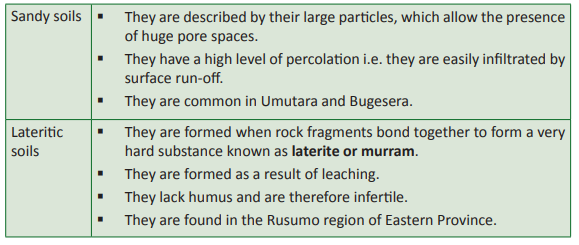
There is a wide range of soils in Rwanda. The soils are classified according to how they
are formed and where they occur. Basing on these classifications, the country has the
following types of soils listed and described in the table below.
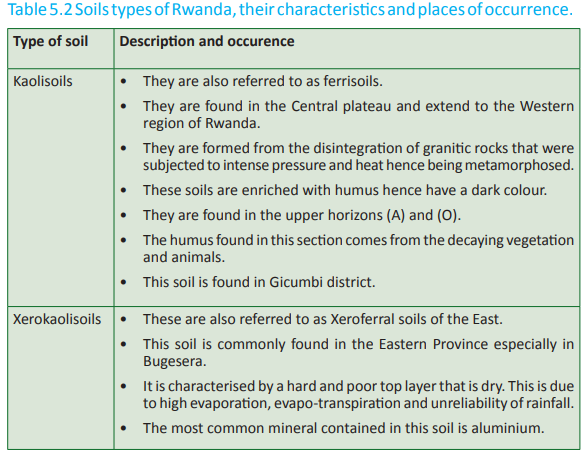
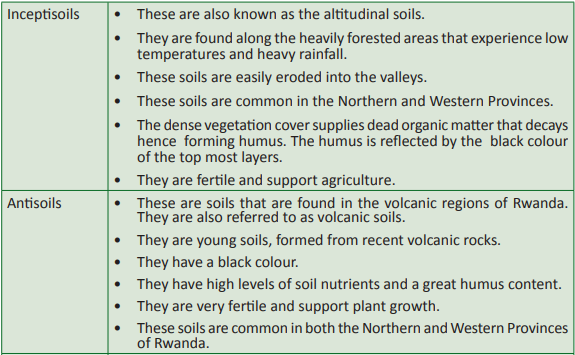

Other soils in Rwanda result from the
physical and chemical alteration of schistose,
quartzite, gneiss, granite and volcanic rocks
which form the surface geology of the
country. These soils are classified as follows:
(a) Soils derived from schistose, sandstone
and quartzite: These are found in
the Congo-Nile crest, parts of the
Central plateau and on the highlands of
Gicumbi district. They make up about
50% of the national land area.
(b) Soils derived from granite and gneiss:
These are found in most parts of the
Central plateau especially Muhanga
and in the Eastern plain. They cover
about 20% of the national land area.
(c) Soils derived from intrusive basic
rocks: These are found in the Northern Province especially Gicumbi and Burera
districts. They cover only about 10% of
the national land area.
(d) Alluvial and colluvial soils: These soils
comprise of minerals found in the
valleys of the Eastern plain and the river
valleys of the Akagera, Nyabarongo
and Rugezi Rivers. They cover about
6% of the national land area. They are
common in the swamps found in the
country.
(e) Soils derived from recent volcanic
materials: These soils are found in the
plateaus of Rusizi and the northwestern
parts of the country. They cover about
10% of the national land area.
(f) Soils derived from ancient volcanic
materials: They cover about 4% of the
national land area.

Activity 5.3
Work in groups of three.
Use the Internet, atlas and other
geographical materials to do the following.
1. Find out the different types of soils in
Rwanda.
2. Find out where they are located in
Rwanda.
3. Draw a sketch map of Rwanda.
4. Locate the different places on the maps
where the different types of soils are
found.
5. Write down the names of the places
located on the maps and the types of
soil found there.
6. Make a class presentation on the
locations of the different types of soil.
Activity 5.4
Rwanda is a country that is gifted with
different relief features giving rise to
different soils.
1. Analyse the importance of the different
types of soils in the regions where they
are located and to the country as a
whole.
2. Write down your findings and present
them in a class discussion.
Task 5.1
1. (a) With the help of a sketch map of
Rwanda identify the locations where
the different types of soils are found.
(b) Describe the characteristics of the
types of soils mentioned in (a) above.
2. Account for the presence of varying soil
types in Rwanda.
3. In relation to Rwandan soils, write short
notes on the following.
(a) Loam soils
(b) Clay soils
(c) Sandy soils
Activity 5.5
Study the photograph shown below and use
the findings of your analysis to answer the
questions that follow.
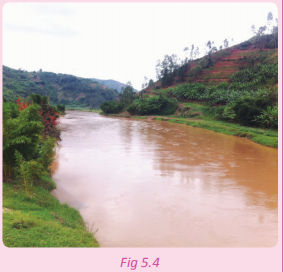
1. Describe the colour of the water
flowing in River Akagera.
2. Why do the waters of the Akagera
River and most of the rivers of Rwanda
have the colour represented in the
photograph above?
3. Identify and explain the main causes of
too much silt in the rivers of Rwanda.
4. Using the geographical skills and
compentences already acquired,
suggest the possible ways of making
sure that the environment is conserved
and managed suistainably.
5. Write down your findings and discuss
them in a class presentation.
Activity 5.6
Work in pairs.
The photograph below shows one of the
areas in Gicumbi District. Study it and
answer the questions that follow.
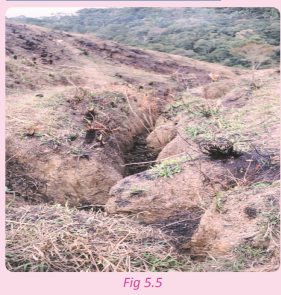
1. Describe the changes on the land
indicated in the photograph.
2. Explain the causes of the changes
identified in (1) above.
3. Examine the effects of such changes on
the environment.
4. Show how best man can conserve and
manage the environment suistainably.
5. Suggest the possible solutions to the
main causes of destruction of land and
soils that Rwanda can implement to
reverse the degradation of land such
as the one shown above.
6. Write down your findings and discuss
them in a class presentation.
Activity 5.7
Work in groups of three.
1. Collect different samples of soil i.e
sandy soils, lateritic soils, loam soils and
clay soils.
2. Each group should have a portion of the
different soil types.
3. Display the soil samples by spreading
them on a flat board.
4. Put water in a watering can and lift it
up to about 11
2 metres high.
5. Gently pour water on top of the
specimens.
6. Critically observe what happens and
note down the findings.
7. Use the findings for class presentation
and to answer the following questions.
(a) What happens to the soil particles
after water drops are poured on
them?
(b) What name is given to the washing
away of the soils?
(c) Explain the various types of the
washing away of soils by either
running water, moving ice or wind.
(d) Apart from water, name other
agents of erosion.
Soil erosion refers to the wearing away of
the top soil from a specific place to another
by water, wind, ice and gravity.
Soil erosion in Rwanda has caused the loss
of large quantities of fertile topsoils. These
soils are washed away and end up in rivers
within the valleys. This explains why many
rivers in Rwanda have coloured water.
The water has too much silt and dissolved
particles of soil washed into the streams.
Soil erosion in Rwanda is made worse
by the steep nature of most parts of the
country. This is the reason areas such as
Nyabihu, Musanze , Rubavu and Muhanga
are affected by soil erosion.
Types of soil erosion in Rwanda
Activity 5.8
Work in pairs.
Use the Internet, Geography textbooks and
other materials.
1. Find out the major types of soil erosion
in Rwanda.
2. Discuss how the different types of soil
erosion identified have affected land
use and the environment in Rwanda.
3. Write down your findings and present
them in a class discussion.
There are mainly four types of soil erosion
experienced in Rwanda. They are described
below.
(a) Sheet erosion
Activity 5.9
Work in pairs.
Study the following photograph provided.
It represents Kabagali area in Ruhango
district where a maize garden was affected
by the running water. Answer the questions
that follow.
1. Explain the process that led to
destruction of the above garden.
2. According to your own experience,
explain how the process happened.

Sheet erosion is a type of soil erosion
where the top soils are washed uniformly
by the running water such as surface runoff.
This occurs mainly along slopes or on
steep pieces of land that have little or no
vegetation cover.
This means that water flows evenly over
an area, wiping off the top soils.
(b) Rill erosion
Activity 5.10
Work in pairs.
Use the photograph provided to answer the
questions that follow.
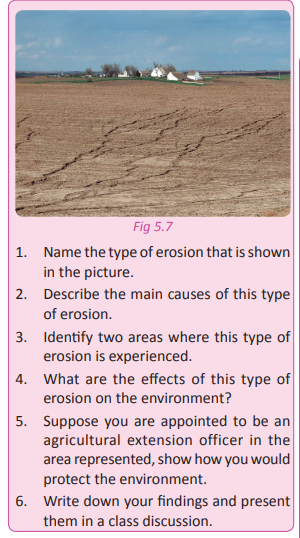 Rill erosion
Rill erosion occurs when several tiny
channels, measuring a few centrimetres
deep are created by water on a piece of
land. The tiny channels are referred to as
rills. The rills in rill erosion usually take a
linear pattern. They are formed by water.
This type of erosion is common in Gashora
area of Bugesera district and in other parts
of Eastern Province. It is more pronounced
during the rainy season. The absence of
vegetation cover speeds up this form of
erosion.
(c) Gully erosion
Activity 5.11
Study the photograph provided taken from
Rushaki in Gicumbi area and answer the
questions that follow.
1. Name the type of soil erosion shown in
the photograph.
2. Identify the main agent of erosion
shown in the photograph.
3. Explain the causes of this type of
erosion.
4. Name other areas in Rwanda where
this type of erosion is common.
5. Describe the effect this has had on the
environment.
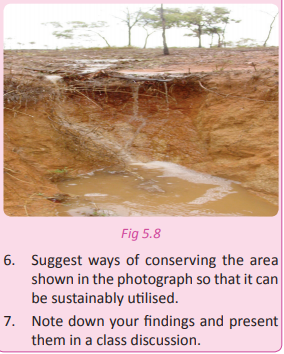 Gulley erosion
Gulley erosion occurs when big depressions
are created by the heavy run-off that
occupies narrow rills. This water widens and
deepens the rills to form gulleys.
This type of erosion is common in parts of Musanze, Gicumbi , Western and Southern
Provinces of Rwanda.
Splash erosion
Activity 5.12
Work in pairs.
Analyse the photograph shown below and use it to answer the questions that follow.
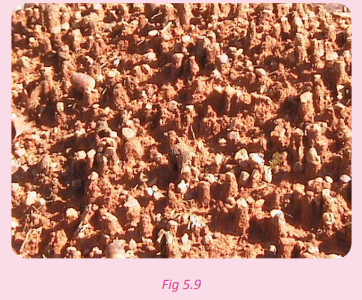
1. Name the type of soil erosion shown.
2. Describe how this type of erosion forms.
3. Describe its effects on the environment.
4. What measures can be taken to avoid such an effect on the environment?
5. Note down your findings and discuss them in a class presentation.
Splash erosion is caused by the force of
pounding raindrops that hit the upper layer
of soils detaching small soil particles from
the unconsolidated soils.
In the process, the soil particles are splashed
away as the raindrops fall on the ground
hence the name splash erosion. This type
of erosion is very common in the Eastern
Province in areas where the vegetation
cover is minimal or completely lacks in
some places.
Task 5.2
1. Define soil erosion.
2. Describe the agents of soil erosion in
Rwanda.
3. Write short notes on the following.
(a) Sheet erosion
(b) Rill erosion
(c) Gully erosion
(d) Splash erosion
The causes of soil erosion in Rwanda
Case study
Miss Mukabananira Vestine a well-known
farmer in Burera district invested a lot of
her time and resources in crop growing.
In 2014, the crop yield was so low and her
funds were wasted. She was so surprised
because she had used a lot of organic
manure in her farm.
Her land was located along a steep slope.
She never followed the advice given to
her by the agricultural extension worker
from her sector. She had been advised to
build terraces on the land and to practise
countour ploughing. On the day that she
ploughed her farm and put the organic
manure, it rained heavily. The run-off from
the upper parts of the slope washed away
the soil carrying the organic manure along
with it.
All these were deposited down slope
into the neighbour’s farm which had a
well prepared terracing system and crops
planted in strips. During harvest time, her
neighbour harvested baskets full of farm
produce.
This was a discouraging experience.
(a) Explain what caused Miss
Mukabananira’s land to be
unproductive despite the generous
application of organic manure.
(b) Why was her neighbour’s yield
bountiful?
(c) Using the geographical knowledge
and skills you have acquired, what
would you advise Miss Mukabananira
to do?
There are many areas in Rwanda that
face severe soil erosion. They include the
following.
• Gicumbi district
• Burera district
• Musanze district
• Rubavu district
• Muhanga district
• Nyabihu district
• Rusizi district
The areas mentioned above experience
severe erosion due to a number of factors.
These factors are divided into physical and
human factors. They are discussed below.
(a) Relief
This influences the occurrence of soil
erosion whereby areas with steep gradients
cause the run-off to flow at high speeds
hence quickly eroding and transporting
the soils. Areas with gentle slopes and flat
regions, the run-off flows at a lesser speed
and the strength to erode is reduced.
(b) Climate Climate leads to the formation of agents of
erosion such as the run-off, moving glaciers
and wind. In Rwanda, rainfall is the most
active agent of erosion. In areas where
heavy rainfall is received the surface runoff present washes away large quantities
of the topsoils. On the other hand, wind
erosion is dominant in areas such as parts of Bugesera and the Eastern Province. There is
also seasonal glacial erosion on the summit
of Mt. Karisimbi especially during the wet
season.
(c) Vegetation
Plants growing in a given area provide a
binding role to the soils. Plant roots hold
the soil particles together enabling them to
resist erosion. The presence of vegetation
reduces the impact of falling rain droplets.
The branches or canopies of forested areas
limit the pounding ability of rain drops.
Areas with less vegetation or bare soils are
subjected to agents of erosion.
(d) Soil erodibility
This is an estimate of the ability of soils
to resist erosion based on the physical
characteristics of each soil.
Soils with faster infiltration rates, higher
levels of organic matter and improved
soil structure have a greater resistance to
erosion. Sand, sandy loam and loam textured
soils tend to be less erodible than silt, very
fine sand and certain clay textured soils.
(e) Poor methods of farming
Farming methods such as monoculture and
ploughing of land along slopes speed up
erosion. They subject the soils to erosion
especially by water.
(f) Mining and quarrying
These activities expose the soils to erosion.
They make the soil particles unstable and
when agents of erosion come by, much of
the soils are carried away. Methods such
as open cast mining cause severe erosion.
(g) Overgrazing
In some parts of Rwanda where animals
are still communally grazed, much of the
soils remain bare due to the clearance of
the vegetation by animals. This exposes the
land to agents of erosion.
 Bush burning
Bush burning
The pastoral communities have a tendency
of burning grass or pasture lands during
the dry season in preparation for the rainy
season. The burning of vegetation leaves
a given area bare and totally exposed to
agents of erosion.
Activity 5.13 Work in pairs.
Use the Internet, Geography textbooks and
journals, personal experience and the local
environment.
1. Find out and explain other causes of
soil erosion in Rwanda.
2. Suggest soil conservation measures
that should be put in place to prevent
and reduce the effects of soil erosion
in the country.
3. Note down your findings and present
them in a class discussion.
Task 5.3
1. Using specific examples, explain the
causes of soil erosion in Rwanda.
2. To what extent is increase in population
a direct cause of soil erosion in Rwanda?
Effects of soil
erosion in Rwanda Case study Miss Dushimimana Sarah conducted a
fieldwork study on soil erosion in one of the
parts of the Eastern Province. In the process
of her fieldwork, she took the photograph
shown in fig 5.10. Study it and use it to
answer the questions that follow.
(a) Define fieldwork study.
(b) Why did Sarah conduct the fieldwork?
(c) Describe what happened to the land
represented by photograph in fig 5.10.
(d) With good reasons, describe the
geographical name given to the
depression shown in the photograph.

There are several effects of soil erosion that
are experienced in Rwanda. They include
the following:
(a) Low soil productivity
Soils subjected to erosion lose all nutrients.
This lowers their economic value. This
is because they can hardly support crop
production due to their infertility.
(b) Low soil moisture
Areas affected by erosion experience loss
of moisture. The removal of the top soils
which would allow infiltration of the run-off
exposes the sub soils which are associated
with soil compaction. This further reduces
the permeability, porosity, and biological
activity of soils hence rendering them
unproductive.
(c) Destruction of crops Wind erosion destroys young seedlings. This
means that extra costs are incurred by the
farmers through replanting. Sometimes,
the sediments being transported are
deposited in farms where they end up
burying germinating seeds to deeper depths
preventing them from reaching the surface.
(d) Affects underground water
Soil erosion sometimes involves run-off
which percolates and dissolves soluble
minerals. Some of the minerals pollute the
underground water. The removal of the
upper layers of soils provides a smooth
surface upon which the run-off flows at
high speeds having no chances of infiltrating
into the soils. This reduces the chances
of increasing the volume of underground
water. Hence, the
water table is lowered. In
some places, springs and other underground
water sources dry up.
(e) Affects transport systems Many roads in Rwanda especially up country
and feeder roads are affected by gullies
created by continuous surface run-off.
This hinders the movement of goods and
services and increases the government’s
expenditure due to frequent rehabilitations.
(f) Flooding
Through soil erosion, sediments are deposited
into lakes, rivers and streams. When there is
too much deposition in a river or lake, its
carrying capacity reduces and becomes
shallow. As a result, water starts overflowing
hence flooding the surrounding areas.
(g) Silting Closely related to the flooding, the silting
problem comes along with increased
expenses of
dredging, resettling people
and total disruption of the eco-system. For
example River Akagera is not suitable for
large ships or motor boats because most
of the parts are shallow and have too much
sediments.
Activity 5.14
Work in pairs.
Use the Internet, Geography textbooks and
journals, personal experience and the local
environment.
1. Find out and explain other effects of
soil erosion in Rwanda.
2. Note down your findings and present
them in a class discussion.
Case study
You have been appointed the minister in
charge of agriculture in Rwanda.
Some regions of the country suffer from
perennial famine. On setting up a task
force to investigate the reason for this,
you discover that the root cause of this is
soil erosion. The soils in the region cannot
support plant growth. The residents of the
region use traditional planting methods.
They plough along slopes, they do not
use fertilisers nor pesticides, they clear
vegetation from the fields by burning them
and most of them keep a large number of
traditional breeds of cattle that feed in a
communal grazing field.
(a) Explain ways in which you will address
the causes of erosion in these regions.
(b) Present your report and
recommendations in a class
discussion.
(c) From the findings of your research and
recommendations from your study,
advise the community around your
school and home on the following;
• Causes of soil erosion
• Prevention
• Management of the effects of
soil erosion.
Soil conservation and
management measures in
Rwanda
Activity 5.15
Study the photograph below and answer
the questions that follow.
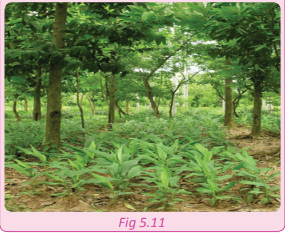
1. Name the type farming being practised
in the area where this photograph was
taken.
2. Why do you think the farmer decided to
plant crops and trees at the same time?
3. Write down your findings and present
them in a class discussion.
Activity 5.16
Work in groups of three.
1. Go outside your school compound.
2. Observe the surrounding environment
in the area.
3. Identify ways in which the people in
that community have prevented and
managed the effects of soil erosion.
4. Write down your findings and present
them in a class discussion.
Soil conservation refers to the prevention
of soils from erosion, degradation or loss
of fertility.
Soil management refers to all the measures
put in place to ensure proper use of soils in
a sustainable manner.
In Rwanda, there are several measures
taken to conserve and manage soils so that
they can be used by humans sustainably.
Some of the soil conservation and
management measures include the following.
(a) Afforestation
Afforestation is the establishment of forests
in an area where there was no forest.
Planting trees where they have never
existed before especially along the steep
slopes of Rwanda checks the rate and
occurrence of soil erosion.
Trees bind the soils together and reduce
the impact of the falling and pounding raindrops. The speed of surface run-off is
also reduced, hence providing soils with a
protecting cover against agents of erosion.
(b) Reforestation
This is the re-establishment of forest cover,
either naturally or artificially in an area.
There are many areas in Rwanda that have
been deforested and reforested by planting
of new trees. The steep areas of Gicumbi
have been reforested by planting of quick
maturing trees. This was done to protect
the soils from erosion and at the same time
to conserve and protect the environment.
(c) Agroforestry This is a land use management system in
which trees are grown around or among
crops or pastureland. Farmers in Rwanda
are encouraged to plant crops and trees on
the same piece of land. This is practiced in
places like Bugesera, Musanze and Rubavu
districts.
(d) Terracing
This is the making of sloping land into a
number of level flat areas resembling a
series of steps. This was advocated for by
the government of Rwanda. Almost, all the
steep slopes demarcated for agriculture
were terraced so as to prevent soil erosion
by surface run-off. Terracing helps in
reducing continuous and lengthy slopes. It
also helps to reduce the speed and impact
of the run-off on the topsoil.
 (e) Contour ploughing
(e) Contour ploughing
This is a form of cultivation where land is
cultivated across the slope instead of along
the slope. In this method, crops are planted
according to the contours of the slope.
 (f) Mulching
(f) Mulching
Mulches are loose coverings of material
placed on the surface of cultivated soil.
They can be applied to bare soil or to
cover the surface of compost. There are
many benefits of
mulching. They include;
retaining moisture in dry and hot weather
and to suppress weeds.
Mulching also prevents the topsoils from
being washed away by the surface run–off.
At the same time, the mulching materials
decay with time adding more organic matter
into the soil hence maintaining its fertility.
(g) Strip cultivation
Strip cultivation is a method of farming used
when a slope is too steep or too long. This
method alternates strips of closely sown
crops such as wheat with strips of row crops,
such as maize and beans.
The growing of cultivated crops in alternating
strips is arranged to follow the contour of
the land and to minimise erosion.
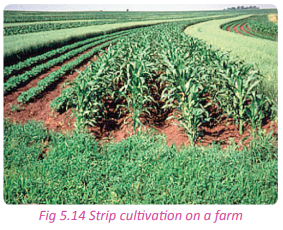
 Crop rotation
Crop rotation
This is a farming practice where a given type
of a crop is grown on a piece of land, after a
different type of crop is harvested from the
same piece of land in the following season.
This rotation balances the soil nutrients.
(i) Application of artificial and organic
fertilisers
It is necessary for farmers to apply both
artificial and organic fertilisers where
possible. This improves the nature and
quality of the soils. The fertilisers and manure enable the soils to support vegetation. The
vegetation plays a great role in protecting
soils against erosion.
(j) Land rotation
This method involves the use of land at
different times. The land is divided into
several pieces. Not all pieces are cultivated
at the same time. Some parts of the land are
left fallow while other parts are cultivated.
This practice allows land to rest and regain
its fertility.
(k) Reducing the number of livestock
Reducing the number of livestock that a
farmer keeps prevents overgrazing which
causes soil erosion.
Activity 5.17
Work in groups.
Use the Internet, knowledge gained in
Geography and other geographical sources.
1. Show how the following soil conservation
measures can be adopted in Rwanda.
(a) Research and training
(b) Establishing specific water points
(c) Planting of cover crops
(d) Row planting
(e) Shelter belts
2. Explain their importance to the soils of
Rwanda.
3. Explain the importance of soil
conservation to Rwanda as a country
Importance of soil in Rwanda
Case study
Use the case study given below to answer
the questions that follow:
Karisa Francis is a resident in the Northern
Province. He has become a renowned
farmer in the region. His harvests are so
encouraging and many families find their
livelihood from the products of his efforts.
He sells his Irish potatoes to his neighbours
and also provides employment to people
in his farm. In the recent past, he decided
to use soil from his farm to make bricks to
extend his house. Soil is an important to the
life of Karisa.
(a) Identify and explain the importance of
soil that are mentioned in Karisa’s story.
(b) Examine other importance of soils to
the socio-economic development of
Rwanda.
(c) Come up with sustainable land use
measures that you can teach farmers
like Karisa to enable them to use soils
sustainably in Rwanda.
(d) Write down your findings for a class
discussion and presentation.
In Rwanda land and by extension soil is a
valuable resource that must be protected
and well managed. Some of its benefits
include the following:
(a) Source of food
The increasing population of Rwanda
depends directly on the agricultural
produce from the farms. Available land and
fertile soils can enable farmers to plant a
variety of crops. The Northern Province is
the national food basket that supports and ensures food security for the masses in
Rwanda. This because the region has fertile
volcanic soils.
(b) Modification of climate Fertile soils support the growth of dense
forests which play a great role in modifying
the climate of Rwanda. In some parts of
Western and Northern Provinces, the fertile
soils have led to the occurrence of dense
vegetation. This has contributed to the
formation of a favourable climate.
(c) Source of raw materials
Soil in form of clay and sand are used in
the construction sector in the making
of materials like bricks and roof tiles. In
Rwanda, the Ruliba Clays Limited Company
is in existence because of the availability of
good quality clay. The bricks used in building
houses are also made from soils.
(d) Research and study
Students who study soil science in the
higher institutions of learning in Rwanda use
soils to understand concepts of their course.
(e) Art and craft Soils such as clay are used in crafts like
pottery. The items made out of clay include,
candle stands and kitchen utensils, flower
vases and other decorative items. These
items assist humans by making their living
better.
(f) Habitat for living organisms
Soils are homelands for living organisms
such as bacteria, algae, fungi and protozoa to
more complex organisms like earthworms,
insects, small vertebrates and plants. These
organisms have a positive contribution to the ecosystem and to the well being of the
soils.
(g) Ground water
Soils allow the infiltration of surface runoff which percolates forming a water
table which is a natural water reservoir
underground.
 Formation of rocks
Formation of rocks
Soils assist in the formation of rocks. The
rocks formed have their contribution to
the development of a country. Rocks such
as sedimentary rocks are formed when
the sediments of soil are deposited and
hardened.
(i) Mineral formation
Soils especially those that are highly saline
lead to the formation of salt and soda ash
which are utilised by humans in various
ways. Peat coal is mined in form of soils that
are found in marshy areas. An example of
such an area in Rwanda is the Rusizi area.
Peat coal is a cheaper source of energy that
is more environmentally friendly. It is used
in many homes as fuel.
(j) Soil supports wildlife and the builtup environment. It also stores carbon and preserves records
of the ecological and cultural past.
Activity 5.18
Work in pairs.
Use the Internet, Geography textbooks,
journals and different soil maps of Rwanda.
1. Examine the variations of soils in
different parts of Rwanda.
2. Give reasons that account for the
variations of the soil types in the
different areas.
3. Draw a table that shows a summary of
the soil types, where they are located
and reasons why they are located in the
places identified.
4. Find out the impact of the soil types
on the distribution of population in the
country.
5. Write up a report on your findings in
the form of a short essay.
Did you know?
• The best soils in Rwanda are formed
from volcanic lavas and alluvium. They
are found in the northwest part of the
country and along the lower portions of
the larger river valleys. (Environmental
profile of Rwanda report)
• Steep slopes, abundant rainfall,
deforestation and intensive farming
contribute to extreme soil erosion in
Rwanda.
• Soil losses from erosion per year
average close to 14 million tonnes
of soil, according to the Ministry of
Agriculture in Rwanda.
• Infiltration benches, terraces,
reforestation and afforestation are the
most widely used soil erosion control
methods in Rwanda.
• Planting of grass and hedge rows is
practiced as part of the biological soil
conservation measures.
End of unit revision task
1. To what extent are humans responsible
for soil erosion in Rwanda?
2. (a) Define soil conservation.
(b) Describe the soil conservation
measures that the government of
Rwanda advocates for.
3. Account for the severe soil erosion in
Northern part of Rwanda.
4. With the help of a sketch map of Rwanda,
describe the soil types of Rwanda.
5. (a) Define soil erosion.
(b) Name and describe the types of soil
erosion.
(c) Examine the effects of the types
of soil erosion that you have
discussed on the environment.
6. Assess the effects of soil erosion on the
socio-economic development of Rwanda.
7. (a) Distinguish between splash erosion
and rill erosion in the context of
Rwanda.
(b) Name the various causes of soil
erosion in various parts of Rwanda.
Bush burning
Crop rotation
Formation of rocks Soils assist in the formation of rocks. The rocks formed have their contribution to the development of a country. Rocks such as sedimentary rocks are formed when the sediments of soil are deposited and hardened.
